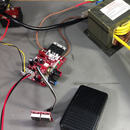Introduction: How to Fix Solder Bridges
In this Instructable I'm going to talk about solder bridges and show you how to deal with them. A solder bridge can happen for many reasons, incorrect soldering temperature, incorrect amount of solder being used, too little or no flux, or just the incorrect technique for soldering but they all basically mean the same thing, a blob of solder shorting two or more conductive surfaces on your PCB.
If you want to learn how to do soldering you can checkout this instructable for smd parts and this one for through hole parts.
Before continuing with next steps, make sure you check out the links I've placed below in the supplies section, You will definitely need these in order to do proper soldering and be able to efficiently remove solder bridges using the methods shown here.
Supplies
A good soldering iron and I can recommend two options here:
- A portable TS100: Link1, Link2, Link3.
- A desktop oriented T12 compatible station: Link1, Link2, Link3.
Solder wick is one of those things that shouldn't be missing from your bench: Link1, Link2.
Flux in general is a must but a good flux can make soldering/desoldering or fixing bridges a breeze: Link1, Link2.
You will need something to clean the soldering iron tip and I would recommend a brass sponge: Link1, Link2, Link3.
Step 1: Watch the Video!
The video describes the entire process of fixing solder bridges with practical examples and tips&tricks so I recommend watching the video first to get an overview of the process. Then you can come back and read the following steps for more detailed explanation.
Step 2: Soldering Iron Tip & Temperature
When fixing solder bridges you typically want a large tip to cover a larger area and be capable of transferring enough heat into the solder wick. I prefer using large knife or chisel type soldering tips.
The temperature you will be using needs to be higher than the normal soldering temperature to compensate for the solder wick sucking some of that heat away from the joint. For example if you are normally soldering at 270 degrees Celsius I would typically go up to 300 degrees when using the solder wick.
Step 3: Method A: No Solder Wick, Just Surface Tension
Now depending on the skills you have, the type of soldering iron tip, how good your flux is, how much solder you have on your bridge, you might be able to wick it away without using any solder wick, just with the soldering iron tip, making use of a thing called surface tension.
Surface tension is the tendency of fluid surfaces to shrink into the minimum surface area possible. And this works in our advantage helping us wick the solder away from the bridge. With repeated tries, cleaning the soldering iron tip before retrying, it might be possible to fix a solder bridge without using any solder wick. But be careful, repeatedly heating that pad or pin with this method might cause damage to the IC or PCB pad so don’t over do it.
Step 4: Method B: Using the Solder Wick
And this is how it’s done with the solder wick, apply some flux, place the solder wick over the bridge and carefully heat with the soldering iron. The solder wick should start sucking the solder. As it gets filled with solder you need to feed in some fresh solder wick. You shouldn’t need too much pressure, just enough to transfer the heat.
The key here is to suck the solder without overheating the component or pcb and without applying too much force. Once the solder bridge has been removed, sometimes there is too little solder left to ensure a reliable connection. If that’s the case, apply some more flux if needed and feed in some fresh solder.
Step 5: Conclusion
With a bit of practice and following these tips and tricks you should be getting excellent results in no time. Soldering and fixing solder bridges really isn’t something complicated, I’m pretty sure everyone is capable of doing it like I said with a bit of info and practice. So, that was all, I hope this instructable was useful if so please leave a comment or hit the like or dislike button to send me some feedback.




